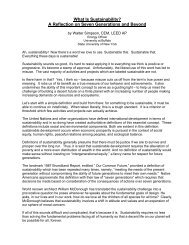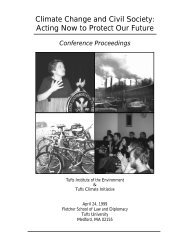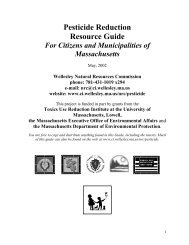Business Guide to Paper Reduction - Tufts Office of Sustainability
Business Guide to Paper Reduction - Tufts Office of Sustainability
Business Guide to Paper Reduction - Tufts Office of Sustainability
You also want an ePaper? Increase the reach of your titles
YUMPU automatically turns print PDFs into web optimized ePapers that Google loves.
Establish a network <strong>of</strong> advisors and advocates.<br />
Concurrently a network <strong>of</strong> advisors and advocates was being built. Because the County consists<br />
<strong>of</strong> 27 diverse departments that may have little interaction between them, an advisory committee<br />
was formed primarily from members <strong>of</strong> the departments that had been identified as <strong>to</strong>p paper<br />
users. This team met every one <strong>to</strong> two months <strong>to</strong> guide the program development, identify areas<br />
that could be priorities, and ultimately implement the education program.<br />
Identify opportunities for paper reduction.<br />
People throughout the county identified ways <strong>to</strong> reduce paper consumption. Some projects, such<br />
as increasing access <strong>to</strong> the County’s internal intranet, were a substantial undertaking, as only one<br />
third <strong>of</strong> county employees had access when the initiative began. The Social Services Agency,<br />
which uses numerous forms in its processes and has frequently-changing policies, began<br />
assessing ways <strong>to</strong> reduce paper. Staff within the agency initiated several projects <strong>to</strong> support<br />
moving from paper <strong>to</strong> electronic tracking <strong>of</strong> cases within the agency, with the potential <strong>of</strong> saving<br />
vast amounts <strong>of</strong> s<strong>to</strong>rage space and s<strong>to</strong>rage costs. Many other agencies were involved in changing<br />
from paper County forms <strong>to</strong> online form access. With funds designated through Measure D, the<br />
County provided financial support <strong>of</strong> up <strong>to</strong> $15,000 <strong>to</strong> departments involved in such efforts.<br />
Numerous individuals also made significant contributions <strong>to</strong> the campaign. One department<br />
s<strong>to</strong>pped distributing some reports and required people <strong>to</strong> walk down several flights <strong>to</strong> get the<br />
report in order <strong>to</strong> discourage its use. One woman in the tax department reformatted the secured<br />
property tax form and saved the county $27,000 and 5,500 pounds <strong>of</strong> paper. 84<br />
Education. Education. Education.<br />
While the County identified larger areas <strong>to</strong> focus on paper reduction, they also determined that<br />
encouraging employee participation at an individual level was important in insuring the<br />
program’s success. Realizing that it would be very difficult <strong>to</strong> reach all employees with an<br />
advisory team <strong>of</strong> ten people, they adopted a train-the-trainers approach. They identified people in<br />
each department that could take responsibility for implementing paper reduction efforts in their<br />
own departments.<br />
To facilitate this train-the-trainers approach, a full day training session was <strong>of</strong>fered for all<br />
department liaisons. This training included watching The <strong>Paper</strong> Trail, a 16-minute video that the<br />
County produced. The video, which is available <strong>to</strong> the public at www.s<strong>to</strong>pwaste.org, focuses on<br />
educating employees about the inefficient uses <strong>of</strong> paper throughout the county and about steps<br />
that were being or could be taken in the campaign. These staff trainers then went back <strong>to</strong> their<br />
departments <strong>to</strong> present the video—which was required viewing for all county employees—using<br />
an educational leaflet and list <strong>of</strong> talking points. Additionally, every employee was given paper<br />
reduction guidelines that helped them understand specific actions that could be taken, and paper<br />
re-use trays were put near printers for scrap paper.<br />
Challenges:<br />
In their initial audit, Alameda County found that the Social Services Agency was one <strong>of</strong> the<br />
largest paper users. Strategically, it made sense <strong>to</strong> target this department for early paper<br />
reduction efforts, yet they discovered two inherent challenges. First, the Social Services<br />
<strong>Business</strong> <strong>Guide</strong> <strong>to</strong> <strong>Paper</strong> <strong>Reduction</strong> 32







